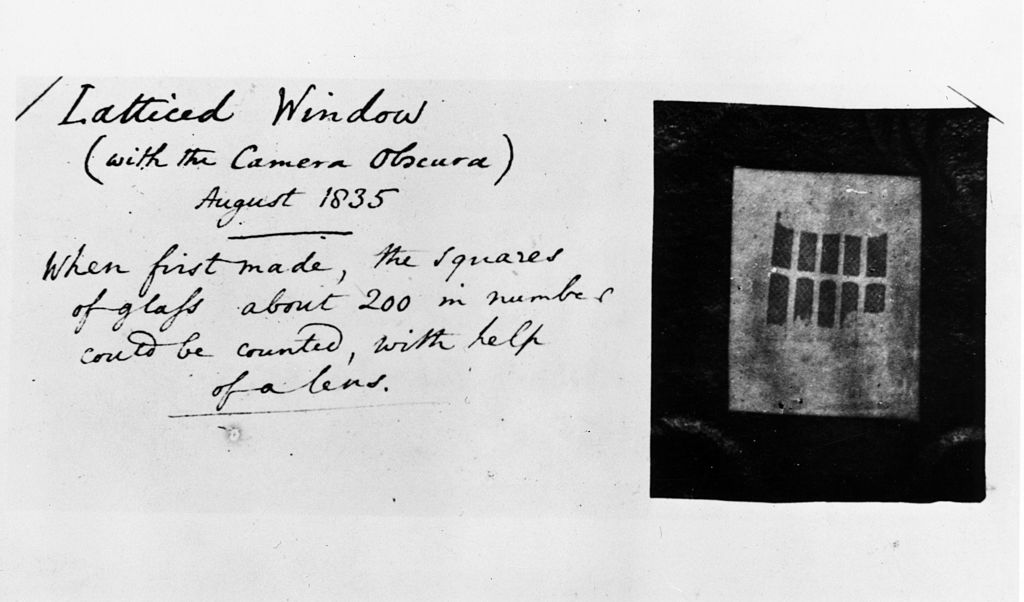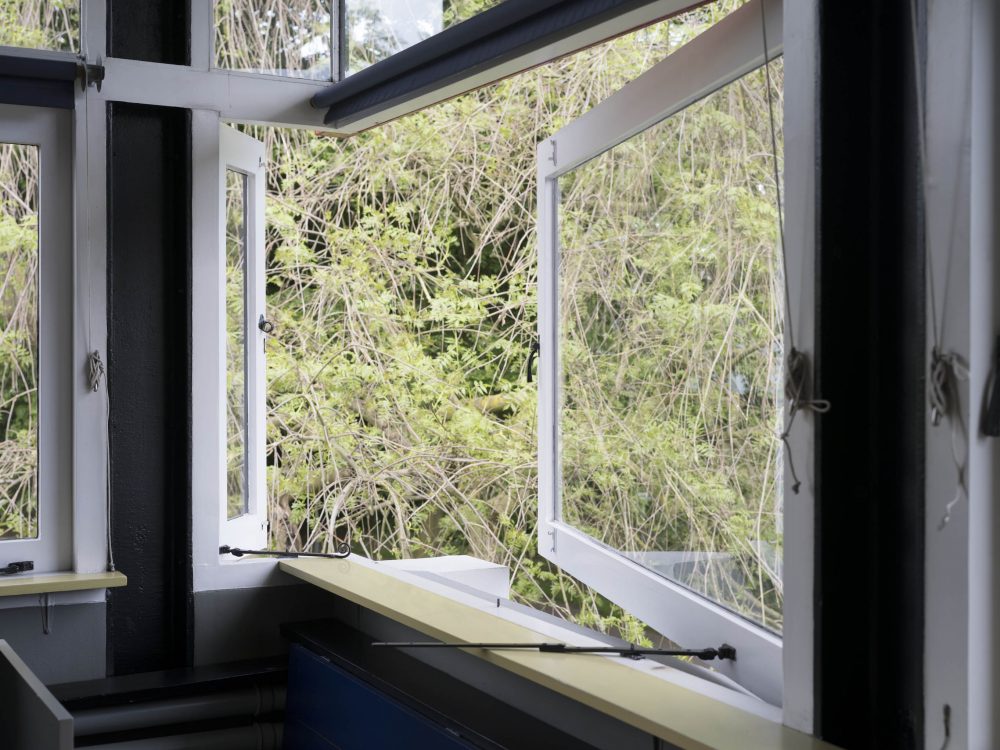
Series Photography was Born at the Window
Ch.2 Symbolic Realism
11 Jul 2019
- Keywords
- Photography
The pioneers (2) Talbot
View of the Boulevards at Paris, 1843
William Henry Fox Talbot was in France between May and June 1843. The main reason for his trip was to teach a series of aspiring calotypists and promote his procedure beyond the Channel (along with the ensuing commercial success). Compared to that of Daguerre, his approach had the major advantage of allowing for multiple positive prints to be made from a paper-based negative. With the help of his faithful assistant Nicolaas Henneman, he transported his photographic equipment over almost four hundred miles from Lacock Abbey, and set up a studio right in the heart of Paris, inside an “isolated and lofty house that stands in the place du Carousel [sic] fronting the Tuileries.”1 Here, his workshop was most likely frequented by some of the pioneers of paper photography, including Hippolyte Bayard (famous for his self-portrait as a drowned man, which he took in October 1840 in order to protest against the indifference of the French government towards his inventions), Henri Victor Regnault, Jean-Baptiste Biot, Hippolyte Fizeau and Jean Louis Lassaigne, who all attended a dinner with him on the evening of 29 May.
His teaching work and his meetings to sell his patent in France, with the help and mediation of the family friend Amélina Petit de Billier, were Talbot’s main commitment during this stay but not his only ones. In fact, he took advantage of his long French sojourn to produce numerous images of the land in which photography (or at least part of it) was invented. The most famous, once again, was taken from a window. It is one of the two images dating back to this journey (the other being a view of a bridge in Orléans) published the following year2 in The Pencil of Nature, which may quite rightly be thought of as the first book of photography in history, considering the necessary and sufficient conditions of this definition as the involvement of a publisher and a print run of a significant number of copies3. Here, every image is accompanied by a brief text, and the one associated with the photograph in question, the second image in the volume, openly reveals its perspective: “This view was taken from one of the upper windows of the Hotel de Douvres, situated at the corner of the Rue de la Paix.”
-

Talbot – View of the Boulevards at Paris, 1843
Talbot was staying at the Hotel de Douvres, and shot a great number of photographs from his quarters, comprised of a circular drawing room with openings in various directions,4ultimately choosing to publish this image for a very specific reason: its likeness with the already known Boulevard du Temple by Daguerre. The analogies between the two images are too numerous to be passed off as a coincidence: both feature a Parisian street, foreshortened, lined with rows of trees along the pavements, lit from the left and with a building in the foreground on the opposite side. The emphasis with which Talbot underlines the descriptive fineness of his method would appear to be a direct response to the eulogies often paid to the meticulous nature of the Daguerreotype, although – given the porosity of the paper base compared to the smoothness of metal – it cannot equal it: “A whole forest of chimneys borders the horizon: for, the instrument chronicles whatever it sees, and certainly would delineate a chimneypot or a chimney-sweeper with the same impartiality as it would the Apollo of Belvedere.”5
But that’s not all, for the two photographs even share the same defect: despite the fact that Boulevard des Capucines was certainly crowded at all times of day, being home to a great number of shops and famous venues such as the Café de Paris, the Maison Dorée and the Jockey Club, also in this case the length of the exposure wiped out the presence of the crowd in movement. Lastly, both images are the result of a gaze that passes through the space of a window. In order to challenge his colleague, Talbot does not choose a conventional frame, but that which more than any other harks back to the very model of photography: a window open on the world. We are very much on Daguerre’s turf here, both geographically (France), and philosophically (realism). And yet Talbot does not back away, quite the opposite. His response is to be found in the very title of his work: the ʻpencil of nature’ is photography itself, meant as an automatic and ineffable operation. In line with the heroic conception of photography, so typical of its early years, it constitutes a sort of spontaneous emanation of the subject, suspended midway between the rules of science and the magic of alchemy. For Talbot, however, this is only one side of the coin. The other comes to the fore in the next image.
Latticed Window, 1835
We need to take a step back. In the month of August 1835, William Henry Fox Talbot produced the first photographic negative to have survived to this day. The subject is a window. Despite the clear connection, it is an entirely different image compared to the examples of Boulevard des Capucines and those of his colleagues Niépce and Daguerre. Those are photographs taken from a window, while this is the photograph of a window. From the issue of realism, we shift here into an extremely modern outlook which today would be likened to conceptual and metalinguistic discourse. While the window constitutes the most immediate metaphor to refer to photography, Talbot doesn’t use it but more simply he photographs it. He thus takes a photograph of photography. The first to comment on this was the author himself, writing a brief note (probably added when it was displayed in 1839) on the card upon which it is mounted. The complete text reads:
-

Fox Talbot – Latticed Window, 1835
Latticed Window (with the Camera Obscura)
August 1835 When first made, the squares of glass, about 200 in number could be counted, with help of a lens6
With these words, Talbot is trying to convince onlookers of the great descriptive capacity of his technique (see above), but not only: at the same time, he is encouraging them to look carefully. As Geoffrey Batchen writes in a brilliant essay on this topic: “If we keep to his written instructions, what we end up seeing most clearly is seeing itself, our own seeing. And we see this seeing more than once. Indeed, Talbot gives a temporal dimension to our act of seeing his image (we are told to look once and then again, through a lens)… And so for Talbot, the subject of this image is, first and foremost, the activity of our looking at it, and only secondly is it the window and the lattice of glass squares.”7
Another detail of this calotype may shed light on the matter. The shot is taken from the interior towards the exterior. Talbot positions his camera in a room of his lodgings in Lacock Abbey and points his lens towards the landscape (we can make out the shapes of a number of trees and another building). The result is a bipartite image: in the centre we have nature, drawing spontaneously through the means of photography, and all around we have mankind controlling the whole operation. If one of these terms had been missing, the image could not have come out (in specific terms, the window could not have been seen). The photographer and the onlookers occupy the dark space beyond the borders of the subject. They (or we) are inside the camera obscura itself, witnesses not just to the apparition of a photograph, but also to the process of its creation.
Lastly, there’s the matter of light. As Batchen underlines once again: “Talbot’s image was taken by pointing his camera directly towards the light.”8 Neither is this a coincidence. Light is a fundamental ingredient of photography, the operative arm of nature in this undertaking of automatic writing. Brought up with a Romantic sensitivity, Talbot certainly exploits its huge symbolic potential, just as many other artists around him do in the same period, from the poets Shelley and Coleridge to the painters John Constable and J. M. W. Turner, the author in those very years between 1835 and 1840 of the first paintings in which light not only gives body to the scene, but with its overwhelming force, destroys a number of details of it and dazzles the onlooker (Sun Setting Over a Lake; Yacht Approaching the Coast…).
Light is also a common thread between the interior and exterior setting. It sets off from the inaccessible level of the sun and then makes its way into the house of the photographer. It crosses the glass of the lens (as it does with that of the window) and leaves its mark on the photosensitive material. By observing light’s capacity for penetration, we discover that the self-reflectivity of Talbot’s photography does not refer merely to linguistic matters, but at the same time responds to the romantic imperative to look inside oneself.
Rouen, 1843
Talbot wrote a great deal, in his manuscripts, his letters, his diaries and the pages of The Pencil of Nature, an authentic meditation on the photographic language, but in no case does he outline the conclusions cited above, which constitute an interpretation of his work. Nevertheless, such re-readings are supported by a number of elements that go well beyond pure chance, highlighting instead a series of intuitions and openings that the photographer does not formalise for cultural reasons (Talbot often seems to sense theoretical implications concerning the nature of photography with so much anticipation as to lack the necessary cultural paradigm in which to analyse and describe them), contingent reasons (from a dialectic point of view, he must choose which topics to give priority to) and subjective ones.
With regard to the specific theme of the window, its importance emerges from the advice he gives in a letter to his aunt Mary Cole, herself involved in a series of photographic experiments: “The object to begin with is a window & its bars, placing the instrument in the interior of a room.”9 According to Talbot, this was the starting point, as if it were a sort of ritual, an initiation process: the photograph of photography that opens the doors to any successive exploration with/on this medium.
What’s more, over the course of his career as a photographer, Talbot produced a huge quantity of shots from windows, on windows, both inside and out. From this point of view, he cannot be compared to any of his colleagues, and nor is an acceptable explanation to be found in the notion that the recurrence of this subject would appear to be a technical issue, to study the effects of sharp contrast (why then should the same insistence not be found among all the photographers of the day?). From the inside of that primigenial window in Lacock Abbey alone, for example, apart from that cited, there are at least five other images, now scattered around the world.10 Even during his journey to France in 1843, Talbot was unable to resist such temptation.
-

Fox Talbot – Latticed Window, 1835 (positive)
On the road to Paris, he stopped off in Rouen, and from his room in the Hotel l’Angleterre, he captured a view of the naval traffic on the Seine.11 It must have been quite a sight, for a few years earlier, J. M. W. Turner had painted various canvases of the same subject, and Talbot describes it as follows in a letter to his mother: “A new suspension bridge crosses the river before my windows. Great bustle and commercial activity manifest everywhere. From early dawn to dewy eve incessant rumbling of carts & wagons – Ships constantly loading, unloading, and moving away – at one moment the quai strewed with large barrels – an hour afterwards not one of them left.”12 Not only does his photograph depict the masts of the boats, the window frame and the wrought iron railing, but also the sumptuous hotel curtains. Talbot does not open them entirely, but calls on the gaze to settle there as well, just before the interior space within the chambre encounters the outside world. A number of scholars have seen in this “a photogram… or human consciousness.”13 They also hint at the veil that photography draws over reality, transforming it into an image.
-

Joseph Mallord William Turner – Sun Setting Over a Lake, 184
Notes and works cited
1. Letter from Talbot to his wife Constance, 7 June 1843.
2. The Pencil of Nature was published in six parts between June 1844 and April 1846.
3. The Pencil of Nature was published by the London-based publisher Longman, Brown, Green and Longmans with a variable print run, ranging from 286 copies of the first part to 89 copies of the last.
4. Cf. Talbot’s letter to his mother, dated 22 May 1843: “It is the corner house with the Boulevards – I chose it on account of the view. My sitting room is circular.”
5. William Henry Fox Talbot, The Pencil of Nature, Longman, Brown, Green and Longmans, London 1844-46, vol. I, p. 18.
6. This object is to be found in the Science Museum Collection in London, catalogued under the number 1937-361.
7. Geoffrey Batchen, A Philosophical Window, in ʻHistory of Photography’, Vol. 26, Issue 2 (Summer 2002), p. 102. A number of passages from this essay are to be found in an Italian translation in Roberto Signorini, Alle origini del fotografico. Lettura di The Pencil of Nature (1844-46) di William Henry Fox Talbot, CLUEB, Bologna 2007. A chapter of this volume (6.5.3. L’immagine simbolica, pp. 274-280) contains numerous reflections of a historical, theoretical and philosophical nature on the subject of the window in Talbot’s photography.
8. Ibid, p. 108.
9. Letter from Talbot to Lady Mary Lucy Cole, 9 August 1839.
10. As well as that accompanied by Talbot’s brief manuscript and kept in the Science Museum in London, the other images of this subject are to be found in the following collections: Royal Photographic Society, Bath, England; Talbot Museum, Lacock, England; Bensusan Museum of Photography, Johannesburg, South Africa; Metropolitan Museum of Art, New York; private collection. Two prints on salted paper, later produced by Harold White, are also to be found in the collection of the Yokohama Museum of Art in Japan.
11. For a detailed study of this image, see Anne McCauley, Talbot’s Rouen Window. Romanticism, Naturphilosophie and the invention of photography, in ʻHistory of Photography’, Vol. 26, Issue 2 (Summer 2002), pp. 124-131.
12. Letter from Talbot to his mother on 15 May 1843.
13. Carol McCusker, First Photographs. William Henry Fox Talbot and the Birth of Photography, powerHouse Books, New York 2002, p. 20.
Francesco Zanot
A photography critic and curator, Zanot has curated exhibitions and written catalog publications with many international photographers. In recent years he has curated books dedicated to artists such as Mark Cohen, Guido Guidi, Olivo Barbieri, Luigi Ghirri, Takashi Homma, Linda Fregni Nagler, Francesco Jodice, Boris Mikhailov, as well as Erik Kessels’s last retrospective The Many Lives of Erik Kessels. Together with Alec Soth, he is the author of the essay Ping Pong Conversations. irector of the Master in Photography organised by the NABA, Milan, he has given classes, conferences and lectures in numerous academic institutions, among them the Columbia University, New York, ECAL, Lausanne, and IUAV, Venice.







